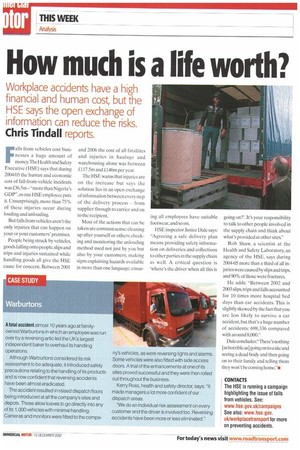How much is a life worth?
Page 20

If you've noticed an error in this article please click here to report it so we can fix it.
Workplace accidents have a high financial and human cost, but the HSE says the open exchange of information can reduce the risKs.
Chris 'Tindall reports.
Falls from vehicles cost businesses a huge amount of money.The Health and Safety Executive (HSE) says that during 2004/05 the human and economic cost of fall-from-vehicle incidents was £36.5m -"more than Nigeria's GDP", as one HSE employee puts it. Unsurprisingly, more than 75% of these injuries occur during loading and unloading.
But falls from vehicles aren't the only injuries that can happen on your or your customers' premises.
People being struck by vehicles, goods falling onto people,slips and trips and injuries sustained while handling goods all give the HSE cause for concern. Between 2001 and 2006 the cost of all fatalities and injuries in haulage and warehousing alone was between £1175m and £146m per year.
The HSE warns that injuries are on the increase but says the solution lies in an open exchange of information between every step of the delivery process from supplier through to carrier and on to the recipient.
Most of the actions that can be taken are common sense: cleaning up after yourself or others; checking and monitoring the unloading method used not just by you but also by your customers; making signs explaining hazards available in more than one language; ensur ing all employees have suitable footwear, and soon.
HSE inspector Janice Dale says: "Agreeing a safe delivery plan means providing safety information on deliveries and collections to other parties in the supply chain as well. A critical question is 'where's the driver when all this is going on?'. It's your responsibility to talk to other people involved in the supply chain and think about what's provided at other sites."
Rob Shaw, a scientist at the Health and Safety Laboratory an agency of the HSE, says during 2004-05 more than a third of all injuries were caused by slips and trips, and 90% of those were fractures.
He adds: "Between 2002 and 2003 slips, trips and falls accounted for 10 times more hospital bed days than car accidents. This is slightly skewed by the fact that you are less likely to survive a car accident,but that's a huge number of accidents: 698,336 compared with around 8,000."
Dale condudes:"There's nothing [as horrible as] going on to a site and seeing a dead body and then going on to their family and telling them they won't be coming home."'






















































































































































































